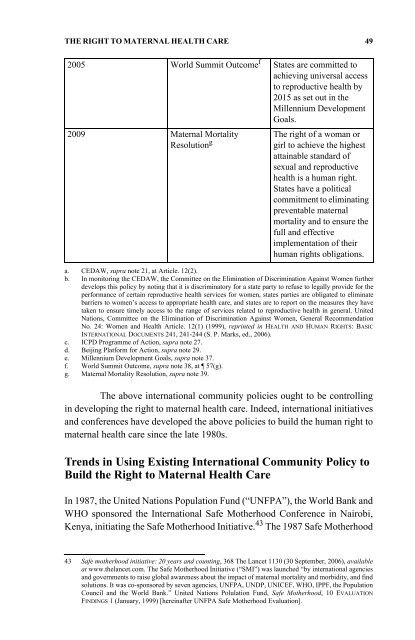University of Botswana Law Journal - PULP
University of Botswana Law Journal - PULP
University of Botswana Law Journal - PULP
Create successful ePaper yourself
Turn your PDF publications into a flip-book with our unique Google optimized e-Paper software.
THE RIGHT TO MATERNAL HEALTH CARE 49<br />
2005 World Summit Outcome f States are committed to<br />
achieving universal access<br />
to reproductive health by<br />
2015 as set out in the<br />
Millennium Development<br />
Goals.<br />
2009 Maternal Mortality<br />
Resolution g<br />
The right <strong>of</strong> a woman or<br />
girl to achieve the highest<br />
attainable standard <strong>of</strong><br />
sexual and reproductive<br />
health is a human right.<br />
States have a political<br />
commitment to eliminating<br />
preventable maternal<br />
mortality and to ensure the<br />
full and effective<br />
implementation <strong>of</strong> their<br />
human rights obligations.<br />
a. CEDAW, supra note 21, at Article. 12(2).<br />
b. In monitoring the CEDAW, the Committee on the Elimination <strong>of</strong> Discrimination Against Women further<br />
develops this policy by noting that it is discriminatory for a state party to refuse to legally provide for the<br />
performance <strong>of</strong> certain reproductive health services for women, states parties are obligated to eliminate<br />
barriers to women’s access to appropriate health care, and states are to report on the measures they have<br />
taken to ensure timely access to the range <strong>of</strong> services related to reproductive health in general. United<br />
Nations, Committee on the Elimination <strong>of</strong> Discrimination Against Women, General Recommendation<br />
No. 24: Women and Health Article. 12(1) (1999), reprinted in HEALTH AND HUMAN RIGHTS: BASIC<br />
INTERNATIONAL DOCUMENTS 241, 241-244 (S. P. Marks, ed., 2006).<br />
c. ICPD Programme <strong>of</strong> Action, supra note 27.<br />
d. Beijing Platform for Action, supra note 29.<br />
e. Millennium Development Goals, supra note 37.<br />
f. World Summit Outcome, supra note 38, at 57(g).<br />
g. Maternal Mortality Resolution, supra note 39.<br />
The above international community policies ought to be controlling<br />
in developing the right to maternal health care. Indeed, international initiatives<br />
and conferences have developed the above policies to build the human right to<br />
maternal health care since the late 1980s.<br />
Trends in Using Existing International Community Policy to<br />
Build the Right to Maternal Health Care<br />
In 1987, the United Nations Population Fund (“UNFPA”), the World Bank and<br />
WHO sponsored the International Safe Motherhood Conference in Nairobi,<br />
Kenya, initiating the Safe Motherhood Initiative. 43 The 1987 Safe Motherhood<br />
43 Safe motherhood initiative: 20 years and counting, 368 The Lancet 1130 (30 September, 2006), available<br />
at www.thelancet.com. The Safe Motherhood Initiative (“SMI”) was launched “by international agencies<br />
and governments to raise global awareness about the impact <strong>of</strong> maternal mortality and morbidity, and find<br />
solutions. It was co-sponsored by seven agencies, UNFPA, UNDP, UNICEF, WHO, IPPF, the Population<br />
Council and the World Bank.” United Nations Polulation Fund, Safe Motherhood, 10 EVALUATION<br />
FINDINGS 1 (January, 1999) [hereinafter UNFPA Safe Motherhood Evaluation].
















